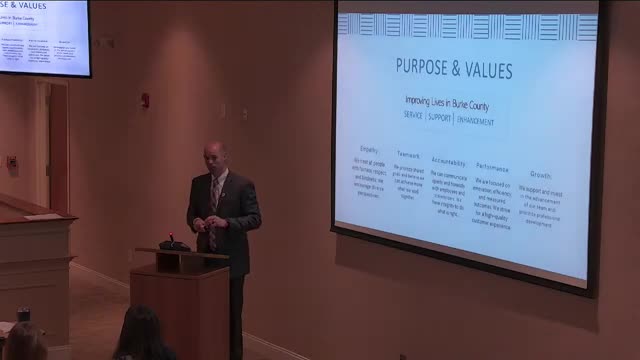Burke County unveils opioid strategy with $24.5M settlement funding
February 15, 2025 | Burke County, North Carolina
This article was created by AI summarizing key points discussed. AI makes mistakes, so for full details and context, please refer to the video of the full meeting. Please report any errors so we can fix them. Report an error »

In the heart of Burke County, North Carolina, a recent government meeting illuminated the county's ongoing battle against the opioid crisis. Under the bright lights of the county hall, officials gathered to discuss strategic planning and the effective use of opioid settlement funds, aiming to improve the lives of residents grappling with addiction.
The meeting featured a community education group, a consulting firm that has been instrumental in guiding Burke County's strategic initiatives over the past few years. Their focus has been on aligning local efforts with a shared purpose: to reduce opioid-related harm and enhance recovery pathways. The local health director and grassroots leaders joined the discussion, emphasizing the importance of collaboration and clear goals in tackling this pressing issue.
A significant highlight was the allocation of approximately $24.5 million in opioid settlement funds, with expectations for an additional $2.5 to $3 million following recent settlements. These resources are seen as a vital opportunity to implement effective strategies aimed at reducing the onset of new users and supporting those ready for recovery. The county has faced alarming statistics, with opioid-related deaths and emergency room visits indicating a critical need for intervention.
The meeting also addressed the management of these funds through a memorandum of understanding (MOU) established by the attorney general's office. This MOU outlines two sets of strategies: Option A, which includes evidence-based practices ready for immediate implementation, and Option B, which offers more flexibility but requires a more complex approval process. Currently, the county has begun implementing Option A strategies, including Naloxone distribution and harm reduction initiatives.
To further enhance their response, Burke County has developed an interactive heat map to track opioid-related calls through their 911 system. This innovative tool aims to identify overdose hotspots, allowing for proactive resource deployment and potentially preventing future incidents.
As the meeting concluded, officials expressed optimism about the path forward. With a strategic plan in place and a commitment to measuring success, Burke County is poised to make meaningful strides in addressing the opioid crisis, ultimately striving to improve the lives of its residents. The collaborative efforts and data-driven approaches discussed during this session reflect a community united in its mission to combat addiction and foster recovery.
The meeting featured a community education group, a consulting firm that has been instrumental in guiding Burke County's strategic initiatives over the past few years. Their focus has been on aligning local efforts with a shared purpose: to reduce opioid-related harm and enhance recovery pathways. The local health director and grassroots leaders joined the discussion, emphasizing the importance of collaboration and clear goals in tackling this pressing issue.
A significant highlight was the allocation of approximately $24.5 million in opioid settlement funds, with expectations for an additional $2.5 to $3 million following recent settlements. These resources are seen as a vital opportunity to implement effective strategies aimed at reducing the onset of new users and supporting those ready for recovery. The county has faced alarming statistics, with opioid-related deaths and emergency room visits indicating a critical need for intervention.
The meeting also addressed the management of these funds through a memorandum of understanding (MOU) established by the attorney general's office. This MOU outlines two sets of strategies: Option A, which includes evidence-based practices ready for immediate implementation, and Option B, which offers more flexibility but requires a more complex approval process. Currently, the county has begun implementing Option A strategies, including Naloxone distribution and harm reduction initiatives.
To further enhance their response, Burke County has developed an interactive heat map to track opioid-related calls through their 911 system. This innovative tool aims to identify overdose hotspots, allowing for proactive resource deployment and potentially preventing future incidents.
As the meeting concluded, officials expressed optimism about the path forward. With a strategic plan in place and a commitment to measuring success, Burke County is poised to make meaningful strides in addressing the opioid crisis, ultimately striving to improve the lives of its residents. The collaborative efforts and data-driven approaches discussed during this session reflect a community united in its mission to combat addiction and foster recovery.
View full meeting
This article is based on a recent meeting—watch the full video and explore the complete transcript for deeper insights into the discussion.
View full meeting
